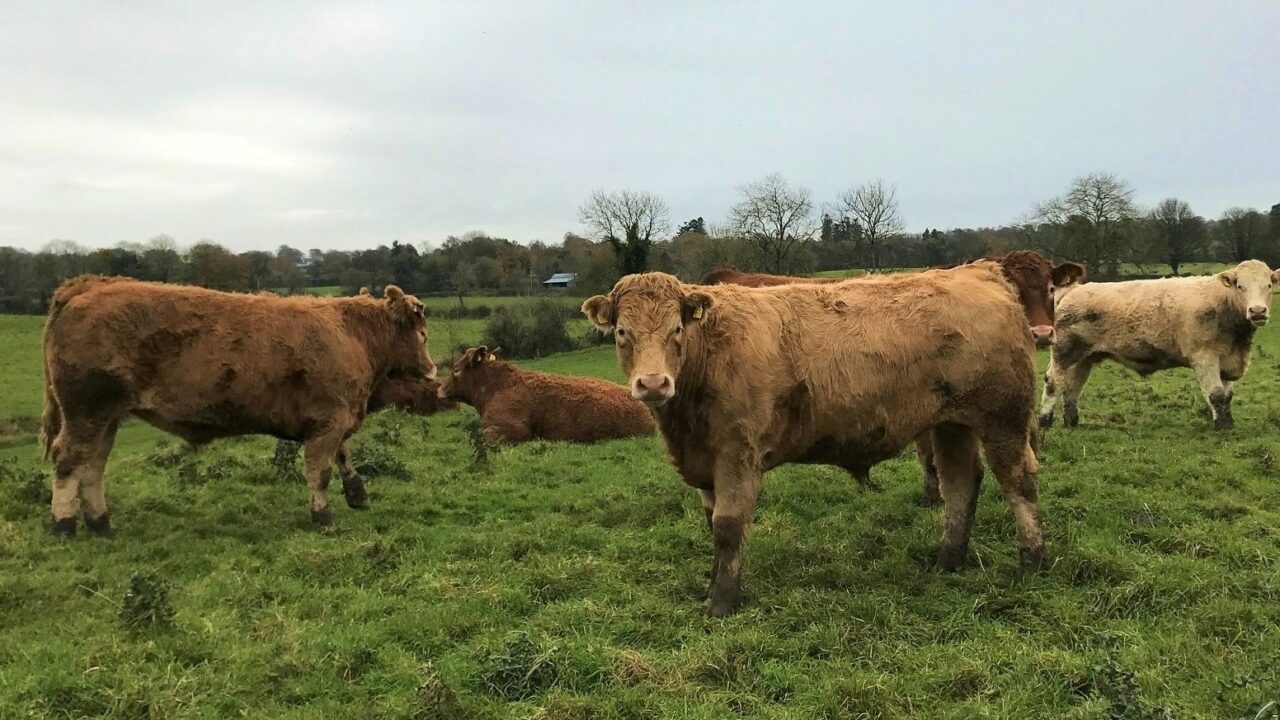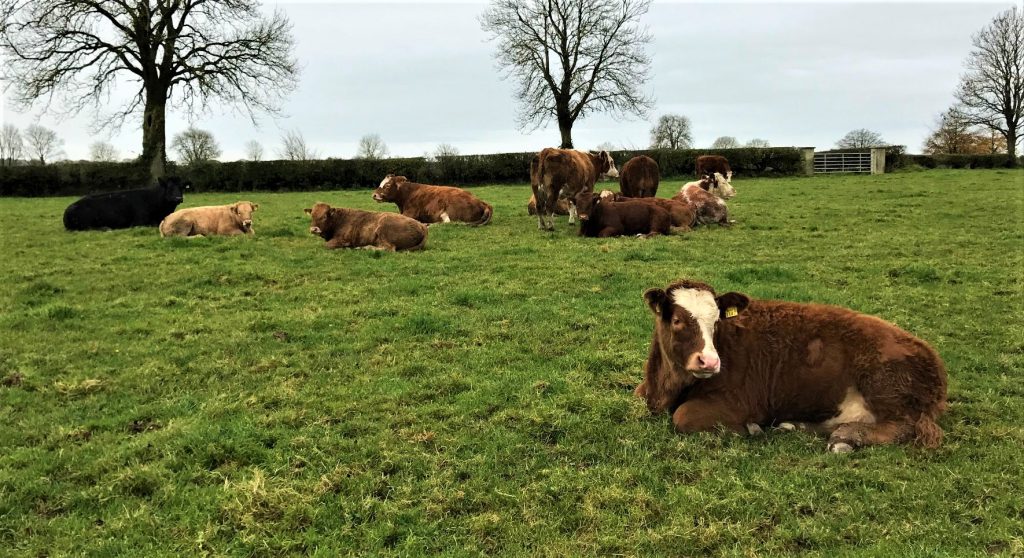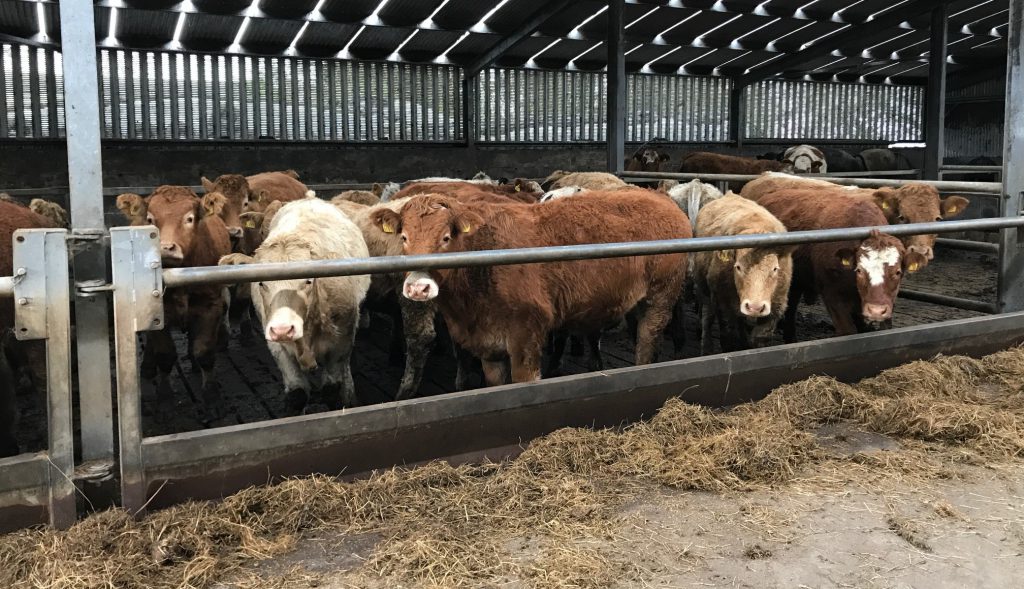“We’re not getting enough for the quality beef that we are producing. We deserve more for the effort we put in; but we have to keep on going.”
Those were the words of Paul Ronan, who farms just outside Mullingar, Co. Westmeath. AgriLand caught up with the Co. Westmeath man earlier this week.
Ronan currently operates a 70-cow, spring-calving herd under a suckler-to-beef system and aims to finish animals off grass at under 30-months-of-age.
The total area of the farm covers 300ac. This includes fields that a cut for hay and silage.
“I have plenty of grass for the stock and I try to do as much reseeding as I can. But, unfortunately, at the margins that we’re experiencing at the moment, it’s just not possible.
I’m not heavily stocked so I can manage. The cattle finish well of grass, but concentrates are sometimes needed to get them over the line.
Currently, it’s a one-man show with Ronan working full-time on the farm; his son Mark is studying agricultural science in University College Dublin (UCD) and has a keen interest in farming.
“He’s into farming and machinery. Hopefully he will get on well up there and bring the knowledge home,” he laughed.
The suckler herd
The 70-cow herd consists mainly of Limousin, Simmental and Simmental cross cows. He said: “I like both of the breeds – they produce nice calves.”
“I also have a handful of Belgian Blue cross cows. They are nice cows – when I cross them with the Limousin bull I get a smashing calf,” he added.
Ronan runs two stock bulls – a Charolais and a Limousin – and are both described as easy calving.
I never have any trouble with the Limousin. Sometimes I have to pull the odd Charolais calf, but it’s seldom in the grand scheme of things.
However, he has tried AI before on some heifers and was happy with the results. Despite this, he plans on sticking to the two stock bulls.
“It worked well, but I’m happy with the stock bulls; they are a great job and produce smashing calves.
“To be honest, it wouldn’t really suit our system here and I think it wouldn’t really suit some of the cows that we have either,” he added.
Any cow that fails to go in calf is culled. However, conception rates are high on the farm and fertility issues are never really a problem. Ronan tries to produce one calf per cow per year.
“Its probably not the best practice but I might give a real good cow a second chance – only if she’s really good,” he explained.
“With the way it is moneywise at the moment, I have to reach that one calf per cow per year target – it’s what I get paid for at the end of the day, ” he said.
Any older cows are culled, fattened and sent to the factory when they are well-fleshed.
No replacement heifers are bred on the farm. Every year, Ronan sources bulling Limousin and Simmental replacement heifers from the west of Ireland. They are bought in mid-April at two-years-of-age and are ready for the bull.
Breeding and calving
The bulls are introduced to the cows mid-to-late April and left to run with them for 12 weeks. Ronan keeps a close eye on proceedings but, generally, there are never any issues.
I don’t use any tail-paint or heat detection methods. I don’t really need to, the two bulls are very good at what they do.
12 weeks breeding in the summer time of the year leaves Ronan with an extremely busy spring. He calves all the cows on his own. The majority of the herd calves within the 12-week period.
“It’s a busy time of the year for me, I’m on my own – but I get through it.
“We are well set up for it now. We have the sheds, the pens and the calving facilities. There was a time when we weren’t as well prepared, but we have ways of dealing with the workload now,” he explained.
As the cows calve, they are turned out to grass – weather depending. “We’re not too bad where we are located. Most of the paddocks are heavy, but they are dry. It’s handy in the spring time of the year.
Once the calf is up and running it’s out the door with mammy.
Winter forage
With the large number of cattle indoors during the winter months, Ronan ensures he has enough quality forage made to see him through. A total of 80ac of silage are harvested in two separate cuts. One cut is aimed to be in by mid-June and another cut is targeted for mid-July.
Ronan also cuts 20ac of good quality hay every year. He said: “We got caught in years gone by. However, we have the shed full of quality hay this year – we saved it all which is great.”
On the silage ground, 2.5-3 bags of cut sward are spread per acre along with slurry. When the first cut is in, 2.5-3 more bags of cut sward are applied. Any additional slurry is also spread.
There are two slatted houses on the farm along with four straw-bedded sheds. The dung from the sheds is spread on the hay fields, which Ronan says is really effective.
We spread the dung and give it a final grazing before closing the gate – it’s a mighty job.
Under 30-month finishing
Ronan is currently finishing his last round of grazing and aims to have all cattle housed by early next week. The herd is split into two groups.
The first group has been already housed and the February-born calves weaned. All animals are treated with Ivomec pour-on. They are also treated for fluke at housing.
All cows are body condition scored at housing and grouped accordingly. Cows are fed good-quality silage throughout the winter.
To be honest, the cows are normally in very good condition. I might pull a few of the thinner cows out and give them some extra feeding, but generally we’re okay that way.
The weanlings are housed in straw-bedded sheds and fed hay, silage and 1kg of meal over the winter months. Ronan aims for 1kg average daily gain (ADG) during the housing period.
He said: “I use mainly a coarse ration and sometimes rolled barley – they do well on it.” Male calves are castrated at nine-months-of-age via the burdizzo method.
Ronan commented on the compensatory growth in the springtime when the weanlings are let out to grass, adding: “They come along nicely over the winter, but they do really well on grass the following spring – you can really notice the difference,” he explained.
The weanlings come back in as stores for the following winter and are fed high-quality silage of 70-75% dry matter digestibility (DMD) ad-lib.
The stores are let out as early as possible the following spring and are allowed graze until slaughter. Ronan normally introduces 6kg of concentrates per day prior to slaughter.
Ronan aims for a kill out weight of 460-480kg for steers and 380-400kg for heifers. “Naturally enough, the heifers are normally finished easier than the steers.
This year Ronan’s cattle killed out well and the majority fell into the R and U-grade category.
What does the future hold?
There are many challenges facing the beef industry in Ireland at the moment and the Westmeath-based farmer is aware that there are no easy tasks ahead.
“Supplies are up this year and there is still a scarcity of beef. However, the factories are not willing to up the price.
“If we were getting 430-440c/kg as a base price we would have a nice margin for ourselves.”
Despite this, he remained upbeat, adding: “I’m going to keep working away at it anyway. There are challenges on the road ahead in relation to Brexit and the beef price, but you have to stay positive.”
I think live exports are very important; they keep things moving.
He also touched on the Quality Assurance Scheme. “I’ve been quality assured from the get go. But, I feel it would make a huge difference if the factories moved to 36 months – I hear a lot of lads saying that.
“There is talk of a premium subsidy of €200/cow being made available for farmers – whether this happens or not is another thing – if it did happen it would make a substantial difference,” he concluded.
Click on a thumbnail in the gallery (below) to open up a full-size image; once opened you can scroll sideways to see the next picture.
























